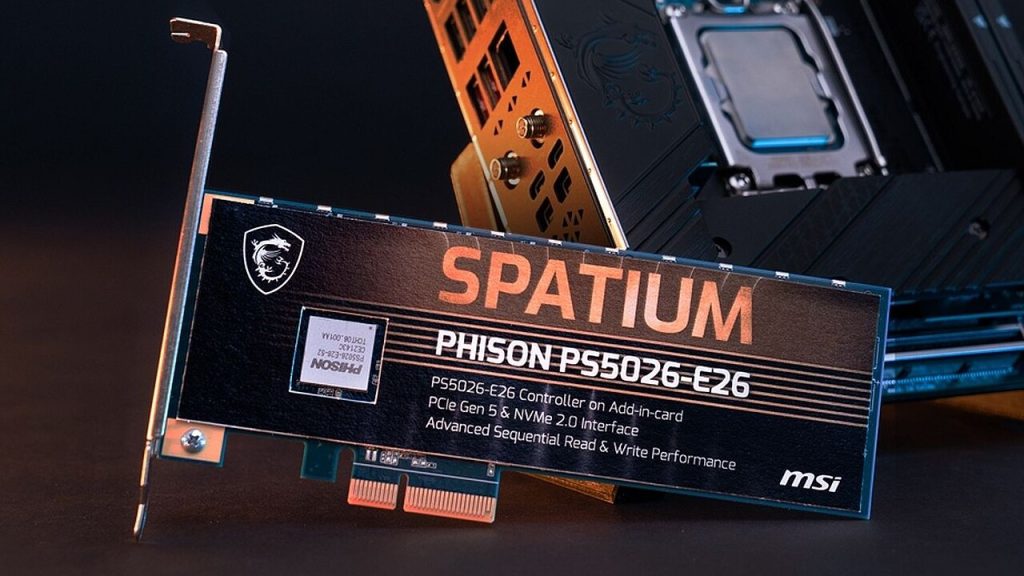SSD controller manufacturer Phison’s CTO talked about the topic of heat generation and cooling in SSDs. With increased performance, fan-cooled SSDs are also becoming a problem, but new connectors may prevent this.
In the interviews, Sebastien Jan, chief technical officer of Phison, spoke about the new challenges in SSD cooling He expressed.
SSD active cooling will soon become a problem
The statement that attracted a lot of attention in the media is: “As we move to Gen5 and Gen6, we may need to consider active cooling‘ Phison CTO is quoted as saying. In his opinion, SSDs will evolve in a similar way to CPUs and GPUs and will become hotter and hotter with ever-increasing performance, and thus will eventually require active cooling.
“There are a lot of things we do to keep the SSD powerful in a reasonable circumstance, but for sure, SSDs are going to be hotter, in the same way that the CPU and GPU got hotter in the ’90s,” Jen said. Gen5 and Gen6, we may need to consider active cooling.”
Even high-end PCIe 4.0 SSDs feature a true heat sink, while the copper foil on the label is often enough for PCIe 3.0 generation. In the end, however, the need always depends on the place of use: in a well-ventilated state, it is easier to dispense with an SSD cooler than, for example, in a small, fanless computer.
A sign that fast PCIe 5.0 SSDs are becoming a “hot potato” is the return of the AiC (Additional Card) form factor, which has all but faded into the PC sector. MSI didn’t prototype its first SSD with the Phison E26 in a compact M.2 form factor, but as an add-on card for the PCIe slot, as the title photo shows. In any case, M.2 SSDs of this performance class should not be expected without a heat sink.
Strategies against hunger for performance
In order to maintain power consumption of PCIe 5.0 SSDs while doubling throughput to 14 GB/s at a similar level to PCIe 4.0 SSDs with around 7 GB/s, Phison is considering different strategies. On the other hand, a precise 7 nm process can be used for the controller, which enables higher clock rates with lower voltages.
We’re trying to stick to roughly the same power envelope as the 7GB/s SSD as we hit 14GB/s by making a lot of other changes.
On the other hand, due to the now faster NAND interfaces, it is now possible to exhaust PCIe 4.0 and even PCIe 5.0 with only four memory channels instead of eight. Gan said that reducing the number of NAND channels has the potential to reduce SSD power consumption by 20 to 30 percent.
You can saturate the host interface with four NAND channels, and reducing the number of back channels reduces the total SSD power by 20 to 30 percent.
However, none of the mentioned procedures were used on the company’s first PCIe 5.0 SSD controller. As it has been known since January, the upcoming Phison E26 (PS5026-E26) will once again be produced at TSMC using the 12nm process and will once again have eight NAND channels. Thus, the CTO must already hint at his successor.
About the importance of real M.2 screws
Aside from the copper foil and heat sinks, “bare” M.2 SSDs actually have the means to dissipate heat. For example, a part is already derived via the connecting pins in an M.2 socket. However, the small screw used to lock the M.2 unit has a much larger stake: according to Jane, the screw refers to “70 percent of the heat conduction path from the SSD to the motherboardAgainst this background, the way some manufacturers replace the screw with a plastic bracket for cost reasons is problematic, as this cuts off an important heat dissipation pathway.
“The screw accounts for 70 percent of the heat conduction path from the SSD to the motherboard,” Jan said. He added that some vendors have started using a nylon screw on the motherboard to save money, eliminating the importance of the connection path.
New connection required
For the M.2 form factor, Sebastian Jean sees the limit reached with PCIe Gen 5. For further performance increases, a new type of connector is needed that improves signal integrity and heat dissipation. New connectors are said to be under development and will appear in the next few years. According to Phison CTO, these could prevent the use of fans on consumer SSDs.
If you look at the bigger question of where computers are headed, there is an understanding, for example, that the M.2 PCIe Gen5 card, as it is today, has reached the limit it can go. The connector will become the bottleneck for increased speed in the future, […] So new connectors are being developed and will be available in the next few years. It will greatly increase both signal integrity and heat dissipation capacity through connection to the motherboard. These new connectors may allow us to avoid placing fans on SSDs.
Allocations have long been made for the server area: the new Enterprise Storage and Data Center Form Factor (EDSFF) is available in different versions, also allowing power consumption of up to 40W with corresponding waste heat. However, these units, which have a much wider connector than an M.2, are usually located directly in the airflow of the powerful and noisy fans in a server cabinet. Requirements in the consumer area are more sensitive.




More Stories
Nvidia GeForce RTX 4090: AIDA64 gets Ada spearhead support
Rogue Trader – Details about the first cRPG in the series – CD-Action
t3n – Digital Pioneers | digital business magazine